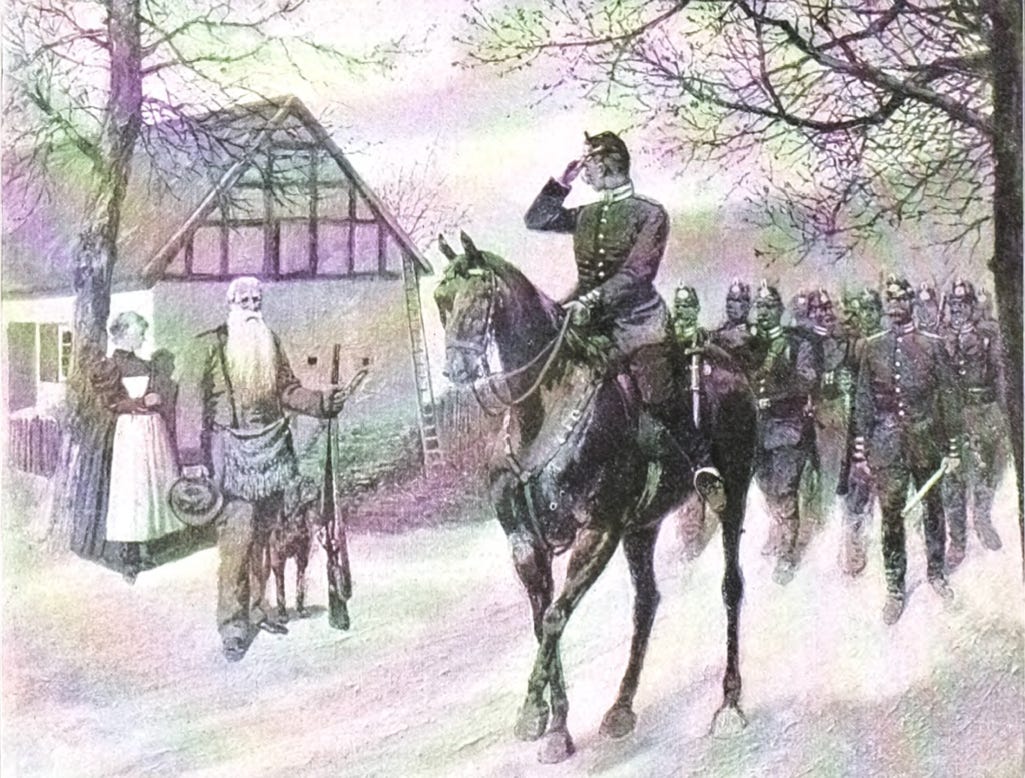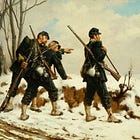In the years that followed the defeat of Napoleon, the formalism of the late eighteenth century once again reared its ugly head. Though vestiges of the reforms of 1806-1815 remained, each passing year saw the line infantry move further and further away from the methods that had brought victory in the Wars of Liberation. The Jäger tradition, however, found safe haven in the Jäger battalions of the Prussian army.
Throughout the 19th century, the game preserves of the aristocracy - those great nurseries of the German hunter - continued to supply trained woodsmen to Jäger units. This practice was strengthened periodically by directives from the Prussian government. In particular, the Prussian War Ministry required that only trained woodsmen should be allowed to re-enlist in Jäger units after the completion of their periods of national service. (This ensured that all of the non-commissioned officers in Jäger battalions possessed the requisite skills in stalking and sharpshooting.) At the same time, the ministry responsible for the royal forests limited service as game-keepers on public lands to veterans who had served in Jäger battalions.
From 1817 to 1853, the commanding officer of the Guard Jäger Battalion served simultaneously the Inspector of Jäger and Schützen. Needless to say, this must have done much to help the Jäger preserve their peculiar way of fighting at a time when the ‘goose-step’ had become the ‘daily bread’ of the German foot soldier. More than that, however, this position of power may have played a role in the protection of Prussian Jäger units against the many organizational challenges they faced during the second half of the nineteenth century.
The power posed by the challenges to the independent existence of Jäger battalions can be seen in the fate of such units in Bavaria and Saxony. In 1878, Bavaria converted six of its Jäger battalions into infantry battalions of the ordinary sort. In 1893, the same kingdom transformed two additional Jäger battalions into line infantry units. In 1900, Saxony sacrificed one of its three Jäger battalions in order to add a third battalion to a two-battalion infantry regiment.
Sources:
Dagobert von Rentzell Geschichte des Ostpreußischen Jäger Battalions Nr. 1 (History of the 1st East Prussian Jäger Battalion) (Berlin: E.S. Mittler, 1882) pages 14 and 15
Peter Hofschröer Prussian Light Infantry, 1792-1815 (London: Osprey, 1984)
Curt Jany Urkundliche Beiträge und Forschungen zur Geschichte des Preußischen Heeres (Berlin: E.S. Mittler, 1901)
Curt Jany Geschichte der Preußischen Armee bis zum Jahr 1807 (Berlin: Karl Siegesmund, 1929) Volume 3
Peter Paret Yorck and the Era of Prussian Reform (Princeton: Princeton University Press, 1966)
The links will take you the websites of Osprey Publishing, the Hathi Trust, the Internet Archive or the Kujawsko-Pomorska Digital Library.
For Further Reading:






